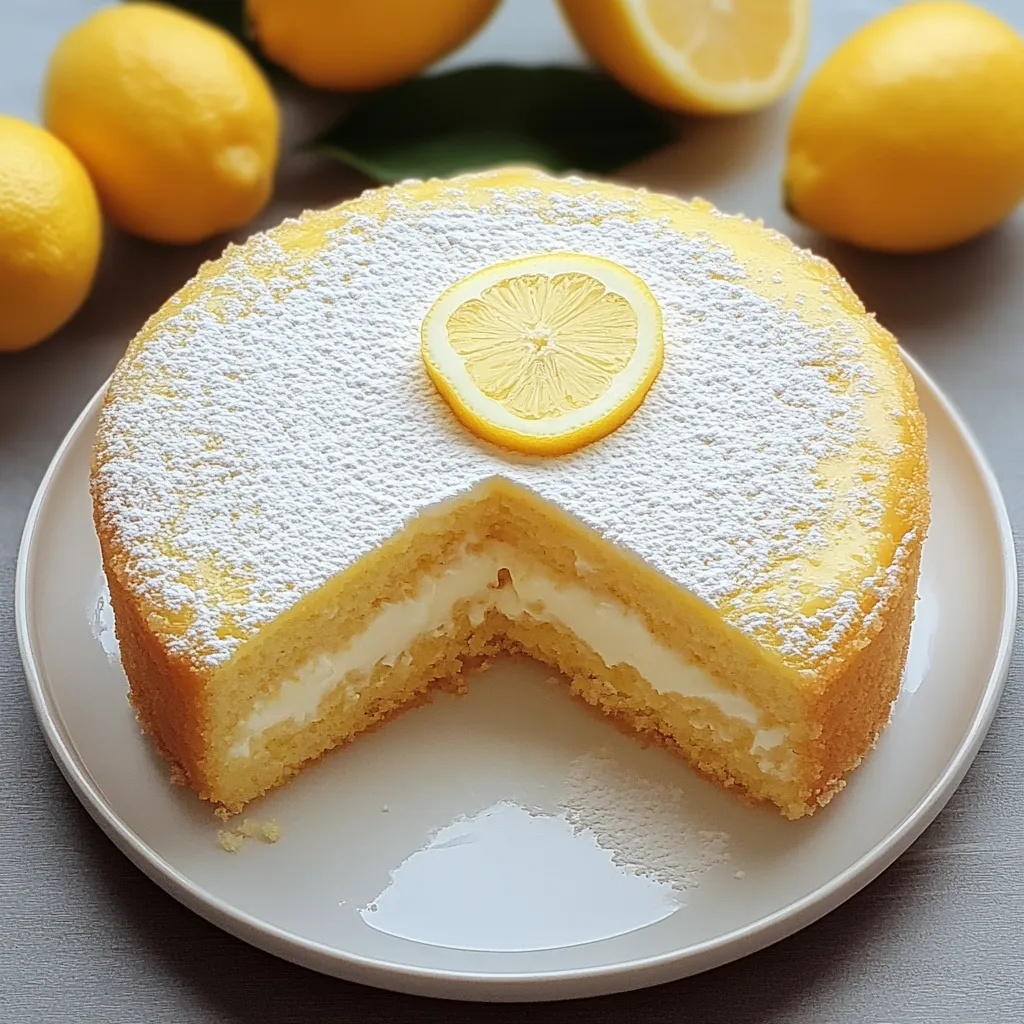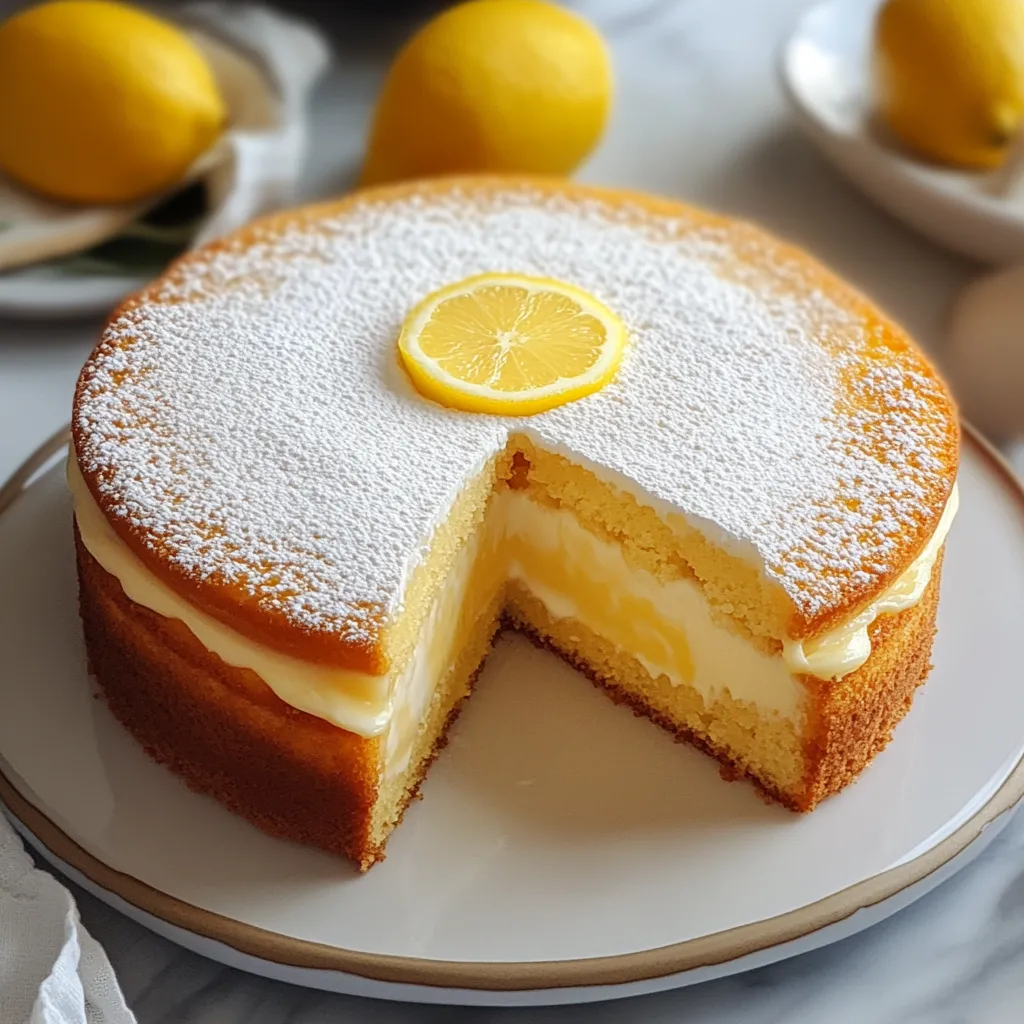 Pin it
Pin it
Lemon custard cake feels like a fun science experiment that turns baking on its head. Out of a single, unassuming mix, you get two gorgeous layers: a soft, airy cake on top and a creamy, pudding-like lemony goodness underneath. Each spoonful hits you with fresh citrus and just the right amount of sweetness. The top bakes golden, while the inside glows with sunny color, so it looks as good as it tastes. What’s wild is how it sorts itself out in the oven on its own—no tricky steps. The lemon keeps things from getting heavy or too sweet, so every bite stays bright and balanced. All those fragrant oils from the zest give it an extra kick that makes it irresistible.
This dessert landed in my life one spring at my grandma’s old house. She brought out what seemed like a basic lemon cake, but it turned out to be the dreamiest custard treat I’d ever tried. Her handwritten card just said “Magic Lemon Cake,” and it really lived up to the hype. I couldn’t get over how common ingredients made something so awesome. When she passed her stack of recipes down to me, I started making this for every get-together where I wanted to look like a kitchen rockstar—without camping out by the stove all day. My friends keep begging for it at birthdays, saying it somehow nails both light and rich dessert cravings.
Dreamy Ingredients
- 1¾ cups whole milk: Makes that delicious custard base happen. You’ll want whole milk here—the fat makes it work.
- ¼ teaspoon salt: Pumps up all the flavor and tones down the sugar. A pinch of fine sea salt does the trick.
- ¼ teaspoon baking powder: Gives the cake top its gentle rise. Make sure yours isn’t expired.
- ¾ cup all-purpose flour: Just enough to set the cake layer without making it heavy. Spoon it into the cup, then level off.
- 4 large eggs, separated: These help pull off the cool split—cake on top, custard beneath. Let them warm to room temp for best results.
- ⅓ cup fresh lemon juice: Brings that zip you want. Fresh-squeezed only; trust me, bottled won’t cut it.
- 3 tablespoons lemon zest: Packs in those bright citrus oils. Zest from 2 or 3 medium lemons should do it.
- ¼ cup unsalted butter, melted: For richness and a tender cake crumb. If you’ve got it, European butter makes it extra fancy.
- ¾ cup granulated sugar: Sweetens things up and helps create the cake’s soft structure. If you have superfine sugar, it mixes in easier.
Easy Bake Steps
- Add Some Tang:
- Whisk in your fresh lemon juice. It might look a bit odd at first—sort of like it’s separating. That’s totally fine. Once you bring in the rest, it’ll come together smooth.
- Build the Base:
- First, whip up the sugar and melted butter in a big bowl. Stir until it goes from gritty to a paler, thick cream. Next, rub in the lemon zest with your fingertips to really let out all those lemony oils.
- Get Everything Ready:
- Set your oven to 325°F and move the rack to the middle. Grease up a 9-inch round pan, then pop a circle of parchment on the bottom so nothing sticks. Bring your fridge stuff out early—when it’s not cold, it mixes in way better.
- Make It Sturdy:
- Split your eggs, keeping the whites in a dry, clean bowl for later. Add the yolks one by one to the sugar mix, whisking after each. By the end, it should look glossy and smooth—this step helps build that creamy custard.
 Pin it
Pin it
I’ll admit, when I first made this cake, I doubted a single batter could really do the job. But once it cooled, I cut in to find that dreamy contrast: a sponge on top, silky goodness underneath. It became my go-to for spring parties, always surprising people with its crazy mix of textures and lively citrus kick.
Fun Ways to Serve
Dress this up for a party by plating slices with fresh berries scattered around them. The color pop gives you instant wow factor and makes the bright lemon flavor stand out. A quick dust of powdered sugar looks fancy but won’t make it too sweet.
Want to level it up? Sprinkle sugar across the top and give it a quick pass with a kitchen torch to create a thin, caramelized crust. It adds a crisp finish that plays off the creamy middle. Top with some soft whipped cream mixed with a little extra lemon for a final touch.
Keeping It Fresh
This cake is in its prime the day you bake it, but you can stretch it out a couple more days if you store it right. Let it cool fully, then cover lightly with plastic and stick it in the fridge. The creamy layer gets richer overnight. After three days, it’ll still taste great—just expect the cake part to blend more with the custard.
For next-day serving, take it out of the fridge about 20 minutes before you want to eat. The texture softens up nicely—perfect contrast between creamy and fluffy. If you need longer storage, wrap each slice snug in plastic and freeze up to a month. When you’re ready, let it thaw in the refrigerator overnight.
 Pin it
Pin it
Last Bits
Even after baking this countless times, I still love how it turns from a regular bowl of batter to something so unique. The magic of those two layers happens all on its own, surprising you every time. It goes to show you don’t need fancy tricks or pricey ingredients for a standout sweet. Sometimes, you just need to know how to let the simple stuff do its thing.
Frequently Asked Questions
- → How does this cake end up with two layers?
- It’s all about science and how the batter works in the oven. The heavy part goes down and becomes the custard, while the lighter part floats and turns into cake. Extra liquid helps this happen, and the eggs do a lot of the work too. Mix things gently and pour carefully, then don’t bump the pan as it cooks so the layers can set up nicely.
- → Could I swap in bottled lemon juice instead of squeezing fresh lemons?
- Yeah, you can use bottled stuff, but honestly, squeezing real lemons gives way more pop. The bottled kind can taste a little flat or bitter, and you’ll miss out on that kick from zest. If you need to use the bottled juice, try to add some extra zest and pick a bottle with the fewest added ingredients.
- → Why did my cake bake as one mass instead of splitting into layers?
- A few things can mess with the layers: mixing too hard can whip in extra air and stop things from separating. Try to mix just until everything is combined. If your oven runs too hot, that can lock the cake together too soon — an oven thermometer helps. Also, if your milk is cold, or if you over- or underbake, the layers won’t show up clearly. Keep an eye during baking and use room-temp milk for best results.
- → Can I bake this ahead and keep it for later?
- Sure thing! This cake actually gets tastier after a night in the fridge since the lemon flavor grows stronger. Whip it up a day or two early, let it chill, and cover it tight. Want it room temp? Just let it sit out a half hour before serving. Dust with powdered sugar when you serve if you’re feeling fancy.
- → Is there a way to make it with no dairy?
- You can go dairy-free if you put in some work. Use a plant-based butter that’s not margarine, and swap in full-fat coconut milk for the regular stuff—thinner milks probably won’t separate right. The cake will get a hint of coconut flavor, and the layers might blur a little, but it still comes out tasty!
